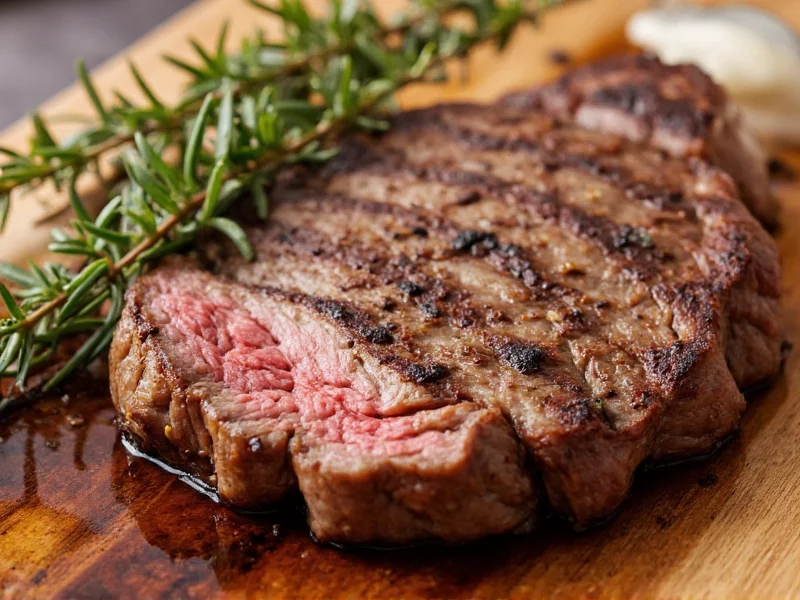When deciding whether to cook steak with rosemary or thyme, understanding each herb's unique characteristics is essential for elevating your dish. These two Mediterranean herbs, while often used interchangeably in casual conversation, create distinctly different flavor experiences that can make or break your steak preparation.
Flavor Profiles: Rosemary vs Thyme
Rosemary (Salvia rosmarinus) delivers a robust, pine-forward flavor with citrus undertones and a slight peppery finish. Its strong character holds up exceptionally well to high-heat cooking methods like grilling and broiling. Thyme (Thymus vulgaris), by contrast, offers a more delicate earthiness with subtle floral notes and a hint of mint. This makes thyme particularly effective in sauces and when paired with more delicate steak cuts.
Best Steak Cuts for Each Herb
| Herb | Best Steak Cuts | Why It Works |
|---|---|---|
| Rosemary | Ribeye, New York Strip, Porterhouse | The herb's bold flavor complements the rich marbling of these cuts without overwhelming them |
| Thyme | Filet Mignon, Flat Iron, Hanger Steak | Thyme's subtlety enhances leaner cuts without competing with their delicate beef flavor |
Cooking Methods and Herb Application
The cooking technique significantly impacts which herb performs better. When grilling steak with rosemary, many chefs recommend using whole sprigs directly on the grill grates. As the rosemary chars, it creates aromatic smoke that infuses the meat. For pan-seared steaks, adding thyme during the final minutes of cooking allows its more delicate flavors to shine without burning.
Professional chefs often employ a technique called herb basting, where they place several sprigs of your chosen herb in melted butter and continuously spoon the infused butter over the cooking steak. This method works particularly well with rosemary for thicker cuts, while thyme benefits from shorter infusion times to prevent bitterness.
Timing Matters: When to Add Each Herb
One of the most common mistakes home cooks make is adding herbs at the wrong time. Rosemary can withstand longer cooking times due to its sturdy structure. For best results when cooking steak with fresh rosemary, add it during the last 3-5 minutes of cooking for grilled steaks, or incorporate it into oil before searing pan steaks.
Thyme requires more careful timing. Its delicate leaves burn easily, so add fresh thyme during the final 1-2 minutes of cooking. When using dried thyme (which concentrates the flavor), use just 1/3 the amount of fresh and add it earlier in the cooking process to allow rehydration.
Flavor Pairing Combinations
Both herbs work beautifully with complementary ingredients that enhance their natural characteristics:
- Rosemary pairings: Garlic, black pepper, olive oil, Dijon mustard, red wine, mushrooms
- Thyme pairings: Shallots, lemon zest, butter, white wine, mushrooms, bay leaf
For a classic rosemary steak marinade, combine 2 tablespoons chopped fresh rosemary, 3 minced garlic cloves, 1/4 cup olive oil, 2 tablespoons balsamic vinegar, and 1 teaspoon black pepper. Allow steaks to marinate for 2-4 hours before cooking.
When preparing thyme-infused steak sauce, add 4-5 fresh thyme sprigs to your pan drippings along with 1/2 cup beef broth and 2 tablespoons unsalted butter. Simmer for 5 minutes before straining and serving over cooked steak.
Avoiding Common Herb Mistakes
Even experienced cooks sometimes make these herb-related errors:
- Using dried instead of fresh without adjustment: Dried rosemary is significantly more potent than fresh (use 1:3 ratio)
- Adding too early: Delicate herbs like thyme burn quickly at high temperatures
- Overcrowding with multiple strong herbs: When cooking steak with rosemary, avoid pairing with other bold herbs like oregano
- Using stems in finished dishes: Rosemary stems are woody and inedible; thyme stems are more tender but still best removed
Professional Chef Recommendations
Top chefs often have strong preferences based on their culinary traditions. French chefs typically favor thyme for its subtlety in classic preparations, while Italian chefs often reach for rosemary to complement robust flavors. Thomas Keller recommends using rosemary with thicker cuts cooked over wood fire, while Gordon Ramsay frequently incorporates thyme into his pan sauce preparations.
For special occasions, consider a dual-herb approach: use rosemary during the initial searing for aroma, then finish with thyme in the sauce. This technique creates complex flavor layers that showcase the best attributes of both herbs without overwhelming the natural beef flavor.
Storage and Selection Tips
Fresh herbs make a significant difference in flavor quality. When selecting rosemary, look for deep green, supple needles that don't crumble when touched. For thyme, choose sprigs with numerous small leaves and minimal bare stems. Store both herbs wrapped in slightly damp paper towels in airtight containers in the refrigerator for up to one week.
If using dried herbs, purchase from reputable spice merchants and replace every 6-12 months for optimal flavor. Properly stored dried rosemary maintains potency longer than dried thyme due to its higher oil content.
Final Recommendation
While both herbs enhance steak beautifully, your ultimate choice should align with your specific preparation. For grilled steak with rosemary, you'll achieve that classic charred herb aroma perfect for summer cookouts. When preparing pan-seared steak with thyme, you'll create a more refined, restaurant-quality dish ideal for elegant dinners. Many professional kitchens keep both herbs on hand specifically because they serve different culinary purposes in steak preparation.











 浙公网安备
33010002000092号
浙公网安备
33010002000092号 浙B2-20120091-4
浙B2-20120091-4